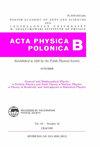均衡与局部性
IF 1.4
4区 物理与天体物理
Q3 PHYSICS, MULTIDISCIPLINARY
引用次数: 1
摘要
由量子力学预言所激发的实验表明,类空间分离测量之间存在着非平凡的相关性。这种现象被称为对强局部性的违反,在爱因斯坦之后,被称为远距离的幽灵作用。一个有趣的、以前未被提出的问题是,粒子集合到平衡态的演化与强局部性有什么关系。更具体地说,在这方面,不可区分的粒子与可区分的粒子是否不同。为了解决这个问题,我们在一组有限的微观状态上引入了一个基于马尔可夫链的框架。我们首次为不可区分粒子制定了服从粒子输运和强局域性的条件。考虑了服从输运局部性并导致平衡态的模型。我们证明了对于不可区分的粒子和可区分的粒子都可以构建服从和违反强局域性的模型。然而,我们发现只有对于可区分的粒子,才有可能在不破坏微观态对称性的情况下,强局部演化到平衡态。这是我们所能施加的最强的对称性,并导致了最短的平衡时间。我们希望本文的研究结果可以为强局部性的破坏提供一个新的视角,并且所开发的框架将有助于未来的研究。具体来说,它们可能有助于解释高能核碰撞的结果,表明难以区分的粒子的快速平衡。本文章由计算机程序翻译,如有差异,请以英文原文为准。
Equilibration and Locality
Experiments motivated by predictions of quantum mechanics indicate non-trivial correlations between spacelike-separated measurements. The phenomenon is referred to as a violation of strong-locality and, after Einstein, called ghostly action at a distance. An intriguing and previously unasked question is how the evolution of an assembly of particles to equilibrium-state relates to strong-locality. More specifically, whether, with this respect, indistinguishable particles differ from distinguishable ones. To address the question, we introduce a Markov-chain based framework over a finite set of microstates. For the first time, we formulate conditions needed to obey the particle transport- and strong-locality for indistinguishable particles. Models which obey transport-locality and lead to equilibrium-state are considered. We show that it is possible to construct models obeying and violating strong-locality both for indistinguishable particles and for distinguishable ones. However, we find that only for distinguishable particles strongly-local evolution to equilibrium is possible without breaking the microstate-symmetry. This is the strongest symmetry one can impose and leads to the shortest equilibration time. We hope that the results presented here may provide a new perspective on a violation of strong-locality, and the developed framework will help in future studies. Specifically they may help to interpret results on high-energy nuclear collisions indicating a fast equilibration of indistinguishable particles.
求助全文
通过发布文献求助,成功后即可免费获取论文全文。
去求助
来源期刊

Acta Physica Polonica B
物理-物理:综合
CiteScore
1.70
自引率
20.00%
发文量
30
审稿时长
3-8 weeks
期刊介绍:
Acta Physica Polonica B covers the following areas of physics:
-General and Mathematical Physics-
Particle Physics and Field Theory-
Nuclear Physics-
Theory of Relativity and Astrophysics-
Statistical Physics
 求助内容:
求助内容: 应助结果提醒方式:
应助结果提醒方式:


